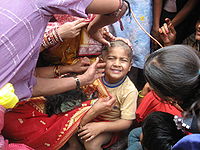Chudakarana
| Part of a series on |
| Hinduism |
|---|
 |
|
|
The Chudakarana (Sanskrit: चूडाकरण, lit, arrangement of the hair tuft) or the Mundana (Sanskrit: मुण्डन, lit. tonsure), is the eighth of the sixteen Hindu saṃskāras (sacraments), in which a child receives their first haircut.

According to the Grhya Sutras, this samskara should take place at the end of first year or before the expiry of the third year, but the later authorities extend the age to the seventh year.[1] The child's hair is shorn, frequently leaving only the śikhā or cūḍā, a tuft at the crown of the head.
Originally, the arrangement of the śikhā was the most significant feature of the Chudakarana and the number of tufts was determined by the number of the pravaras belonging to the gotra of the child. Later, in northern India, keeping only one tuft became universal. But in the Deccan and southern India, earlier traditions remained alive to some extent.[2]
In tradition, the hair from birth is associated with undesirable traits from past lives. Thus at the time of the mundana, the child is freshly shaven to signify freedom from the past and moving into the future. The rite is performed as a special ceremony in most homes, for young girls and boys.
At Rishikesh, on the banks of the Ganges, there is a special chudakarana or mundana samskara. In this ceremony, along with cutting and shaving hair, Vedic mantras and prayers are chanted by trained priests, acharyas and . The child's head is shaven and the hair is then symbolically offered to the holy river. The child and his/her family then perform a sacred yajna ceremony and the .
Versions in India[]
The method of mundan is almost similar in Hindu households, Still if observed pricesely , the mundan sanskar after death of dearly member varies a lot depending on the culture or ethnicity. In most of Indian households head is shaven (mundan),after the death of any member in same clan(kul) or relation. But in parts of greater Deccan and Mysore state, head is only shaven after the death of parent, different from rest of Indian families. Historian Ghulab Chaudhary[3] states a reason for this change in Deccan. He states that "Hindu scriptures witnessed the mundan after demise of dearly man from same kula. But the change of custom in Deccan region is because of religious policies of rulers before independence. The Nawabs imposed religious tax (jizya) on half shaven hindus and other customs. So gradually the custom changed and took a new form and people here shave head only after demise of any one of parent." Still many Hindus from Deccan follow same custom throughout.
See also[]
References[]
- ^ Pandey, R.B. (1962, reprint 2003). The Hindu Sacraments (Saṁskāra) in S. Radhakrishnan (ed.) The Cultural Heritage of India, Vol.II, Kolkata:The Ramakrishna Mission Institute of Culture, ISBN 81-85843-03-1, p.403
- ^ Pandey, Rajbali (1969, reprint 2006) Hindu Saṁskāras: Socio-Religious Study of the Hindu Sacraments, Delhi:Motilal Banarsidass, ISBN 81-208-0434-1, pp.98-99
- ^ "Mundan Ceremony process". badhaai.com.
- Samskaras
- Hinduism stubs
